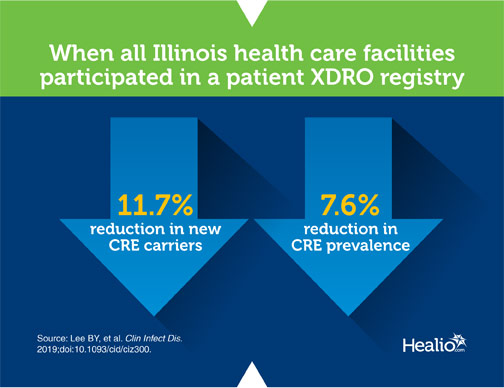XDRO registry could reduce spread of CRE, ‘even with modest participation’
Click Here to Manage Email Alerts
A registry that tracks patients who carry extensively drug-resistant organisms can reduce the spread of carbapenem-resistant Enterobacteriaceae in a region even if only 25% of the largest health care facilities participate, according to a study centered in Illinois, which found that the registry benefited even nonparticipating facilities.
“Regions concerned about the spread of extensively drug-resistant organisms (XDROs) have considered building and using electronic registries that can track which patients are carrying antibiotic-resistant bacteria and can alert health care facilities about these patients when they get admitted. Implementing such registries can require time, effort, and resources; therefore, there is a need to better understand how such registries may improve the control of the spread of XDROs such as carbapenem-resistant Enterobacteriaceae (CRE),” Bruce Y. Lee, MD, MBA, associate professor of international health and executive director of the Global Obesity Prevention Center at Johns Hopkins Bloomberg School of Public Health, and colleagues wrote.
“Before implementing such a registry, policymakers ... may have several questions: Should a state or region implement an XDRO registry? What is its impact on pathogen spread? How would variation in facility participation impact its effectiveness?”
To answer these questions, Lee and colleagues developed a model of all the health care facilities in the greater Chicago region to explore the impact of a registry tracking patients who carry CRE vs. having no registry. The model included 90 acute-care hospitals, nine long-term acute-care hospitals, 351 skilled nursing facilities and 12 ventilator-capable skilled nursing facilities.

According to the study, Lee and colleagues calculated a 9.1% relative reduction in the number of new carriers and a 2.8% relative reduction in CRE prevalence in participating and nonparticipating facilities over 3 years when only 25% of facilities participated in the registry. Results showed that when all Illinois facilities participated, the registry reduced the number of new carriers by 11.7% and CRE prevalence by 7.6% over 3 years.
According to Lee and colleagues, when 75% of the largest Illinois facilities participated, there was an 11.6% relative reduction in new carriers and a 5.0% relative reduction in prevalence. When half participated, the relative reductions were 10.7% and 5.6% in incident carriers and prevalence, respectively.
“Implementing a regionwide XDRO registry could reduce CRE’s spread in a region (up to 15.5% relative reduction in new carriers over 3-years). Benefits accrue even with modest participation by facilities, benefiting both participants and nonparticipants,” the authors concluded. “We found that a registry can provide independent effects of disease prevention, even before additional public health prevention measures are implemented.” – by Caitlyn Stulpin
Disclosures: Lee reports no relevant financial disclosures. Please see the study for all other authors’ relevant financial disclosures.
